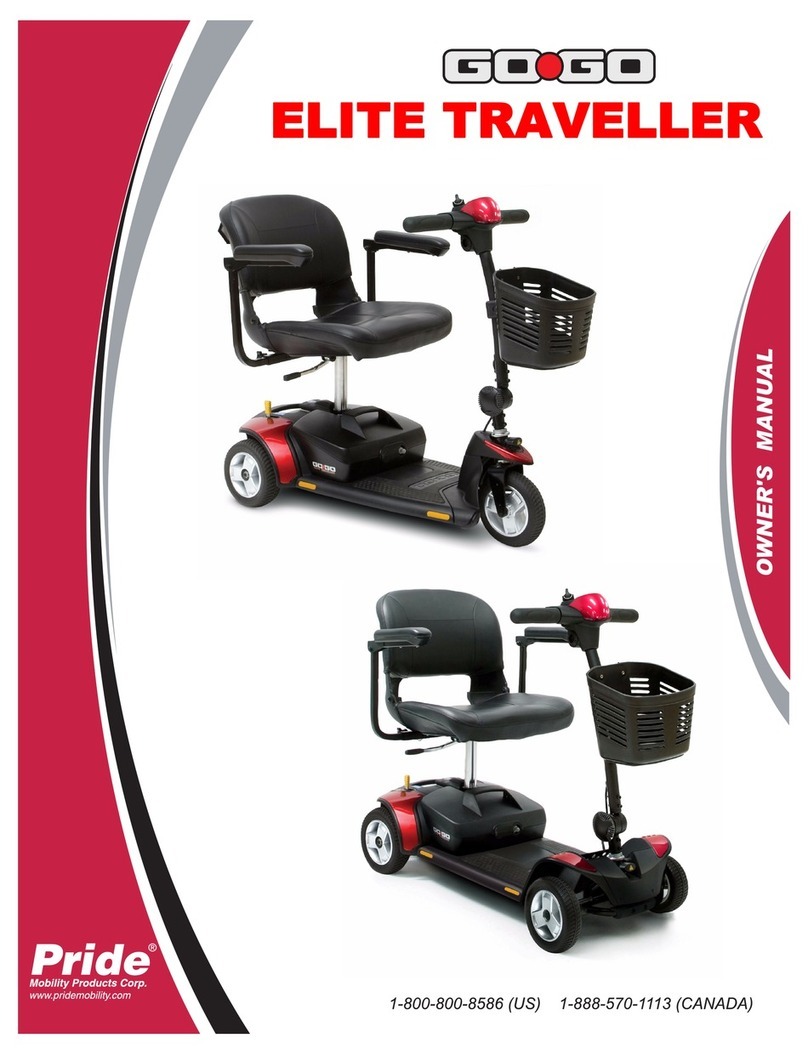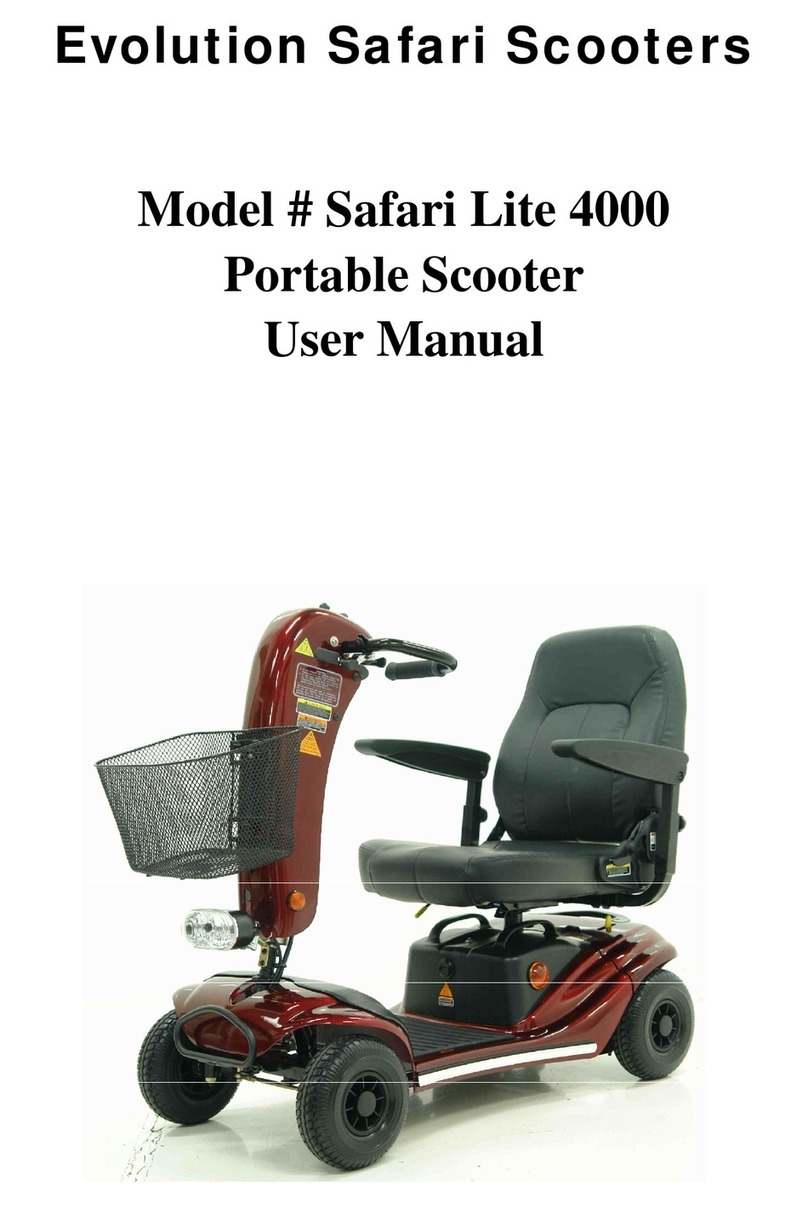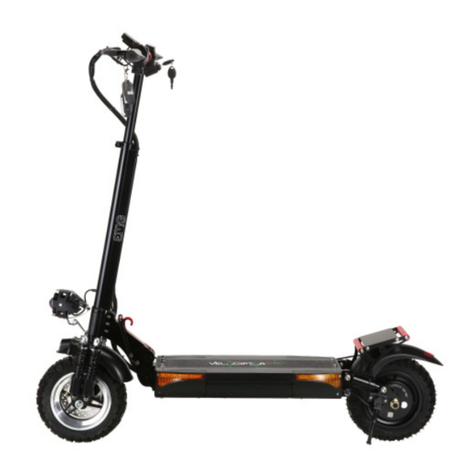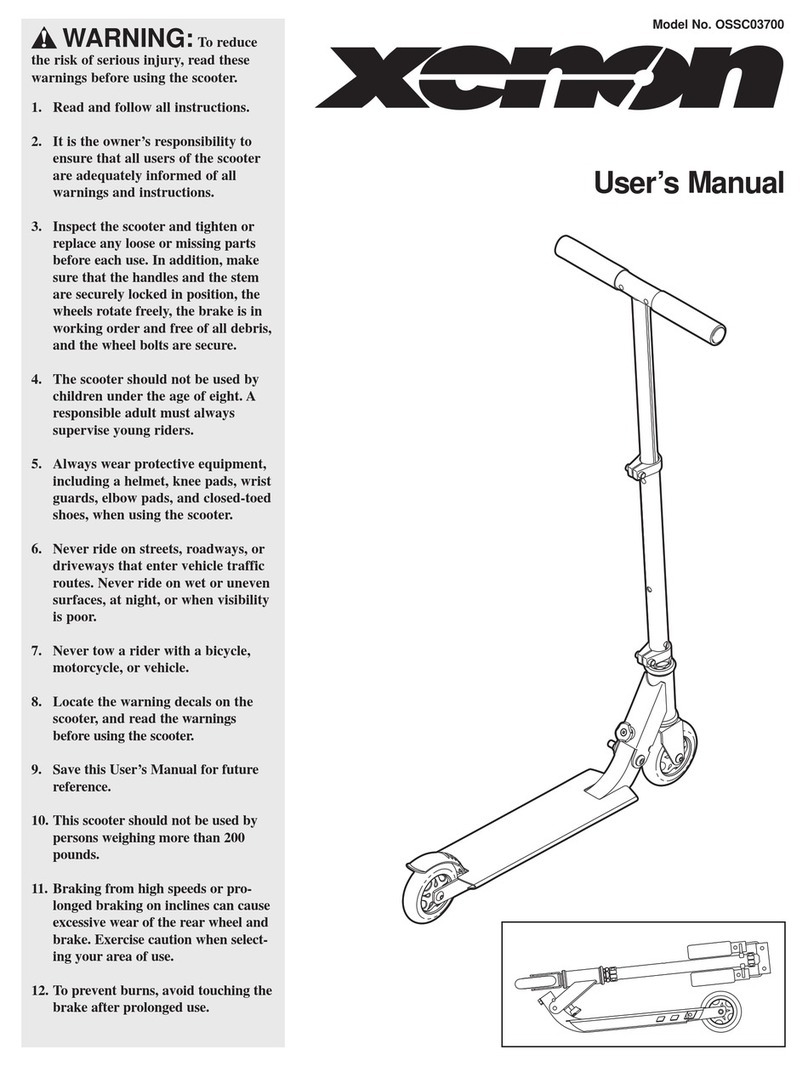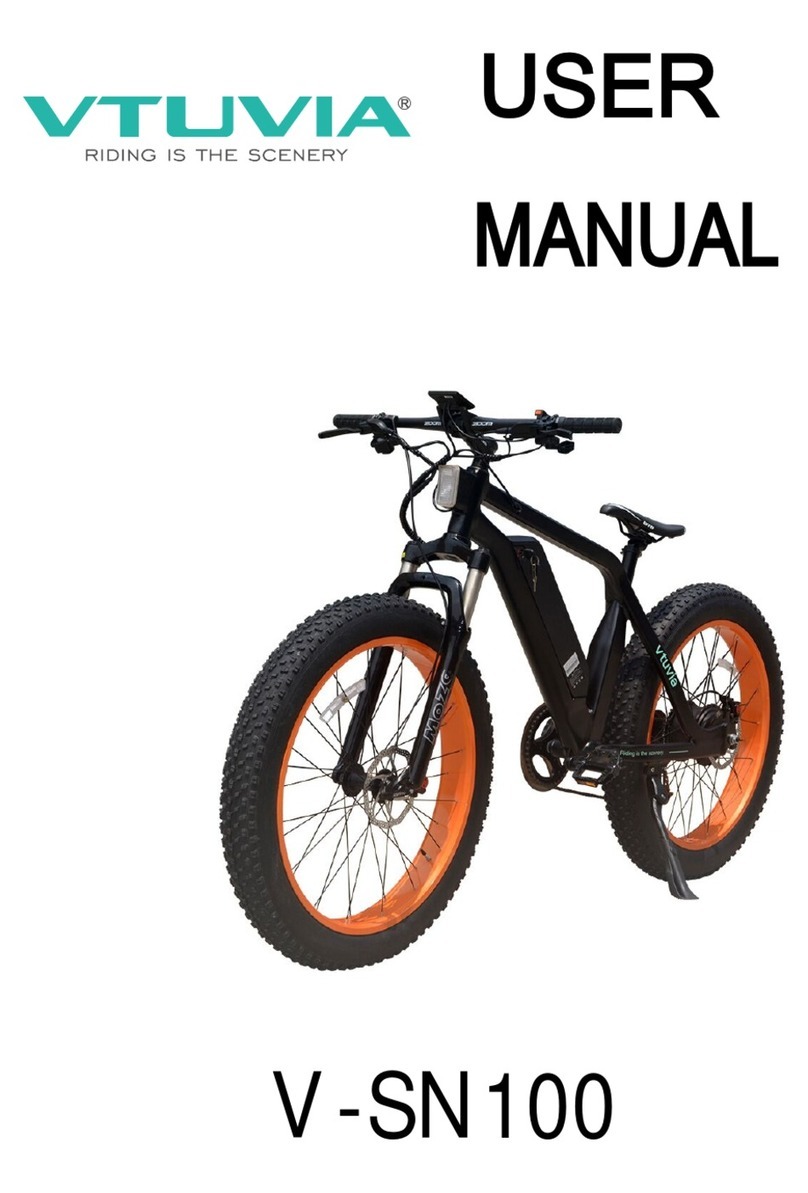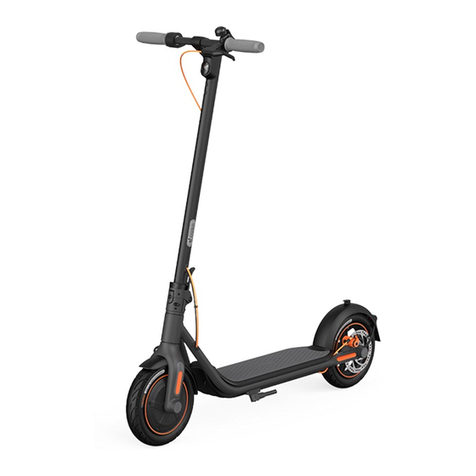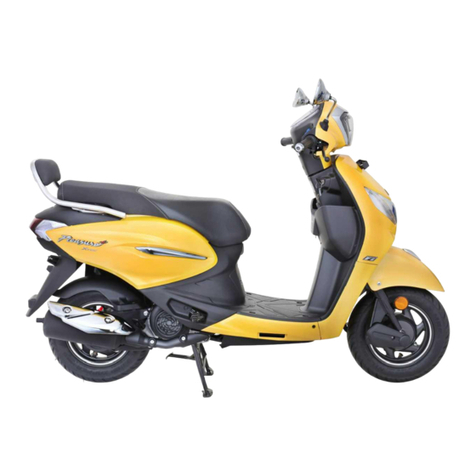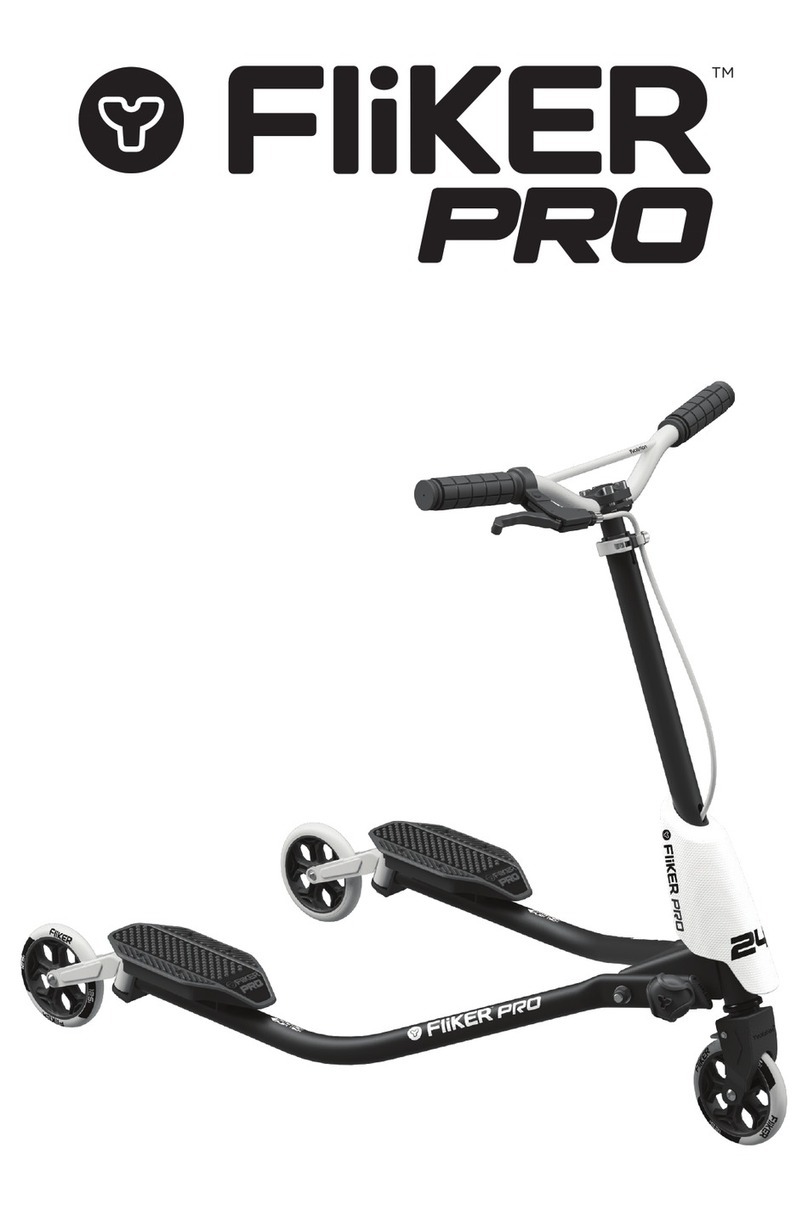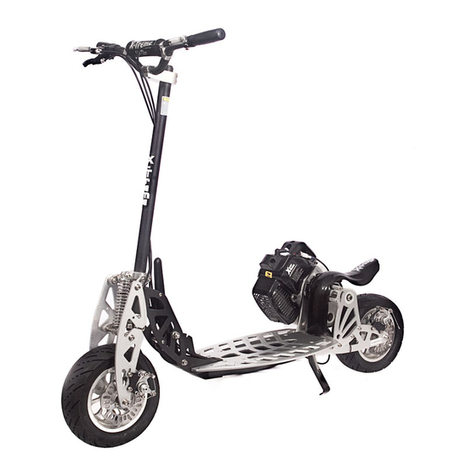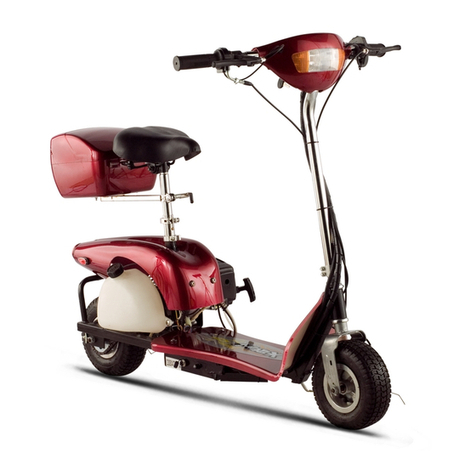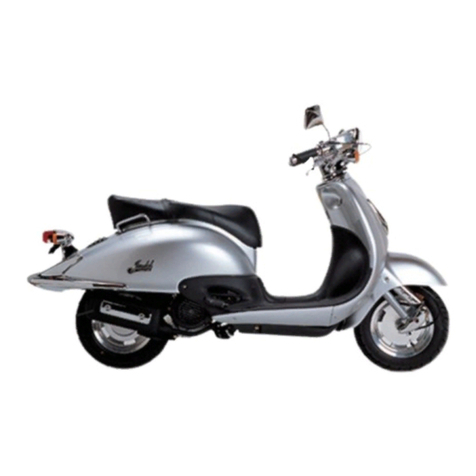Fortis FS14IEBIKEA User manual

14 36V 5.2AH FOLDABLE
ELECTRIC BIKE
FS14IEBIKEA


IMPORTANT: Read this user guide and keep for future reference.
The rider must wear a helmet and appropriate safety gear when operating this bike. Ensure
local laws and regulations for electric bike use are followed at all times.
ATTENTION: This bike is designed for city roads and must not be operated in non-urban
road or off-road environments.
WARNING:
Riding on
motorways or other
dangerous roads is
strictly prohibited.
Only operate with two
hands on the handlebars.
Do not ride with one hand,
do not ride with no hands.
Be careful to not
operate the throttle
when pushing the
bike.
Do not ride on stairways.
CAUTION:
•User must read all local traffic regulations before operating on public roads and
pathways.
•The rider must wear a helmet and appropriate safety gear when operating this bike.
Examples of safety gear include (but not limited to) gloves, elbow pads, knee pads, etc.
•Always check your bike before riding. Ensure that the brakes work well, the battery is
fully charged, tyre pressure is correct, and that no screws have become loose. Listen for
any abnormal sounds.
•Not for use in poor weather conditions, such as slippery roads. Never operate in snow,
hail or medium to heavy rain.
SAFETY & WARNINGS

•If you must ride when in light rain, keep at a low speed and ensure a long distance from
the vehicles in front of you in case of emergency stops. Ensure you are using the
headlight.
•Do not ride on slopes steeper than 15°.
•Not for use by children below the age of 12.
•Avoid sudden acceleration and deceleration.
•Do not exaggerate leaning, either forward or backward, while riding.
•If remaining battery power is low, ride on low constant speed and charge the battery as
soon as possible.
•If a fall is inevitable, always prioritise your own safety before the bike.
•Do not put your hands in the pocket while riding – only operate with two hands on the
handlebars at all times.
•Do not store your bike in car boot/trunk for long periods of time during hot weather.
•Always stay aware of your surroundings while operating. Be aware of the conditions
and avoid any potential collisions.
•Keep a safe distance from others while riding and do not ride “neck by neck” (closely
beside) with others.
•Do not ride in dim, dark, or poorly lit locations. If necessary for travel, we recommend
not riding and instead pushing the bike while walking, and ensure you are using the
headlight.
•Do not ride backwards and do not perform any actions that might endanger yourself or
others while riding.
•Do not lend this bike to those who have not read this user guide.
•Do not ride while you feel unwell, nor after consuming alcohol or drugs. This product
has the potential to endanger yourself and others if not operated responsibly.
•Do not lift your bike off of its tyres.
•At all times avoid that your fingers get stuck between the tyre and the casing, or
between the wheels and the bike frame.
•Only accelerate slowly. Sudden acceleration may lead to loss of balance and injury.
•Check the brakes before riding. Regularly adjust the brake wire tension to ensure it is
safe.
•The brake lever control is left for the front brake, right for the rear brake.
•The Power Assist Sensor (PAS) will start to work when pedalling ¾-1 cycle. Beware of
the crank rotating while walking.
Carrying Guide

1x Foldable Electric Bike
1x Charger / Adapter
1x User Guide
COMPONENTS

Bike overview:
OVERVIEW
Hand grips
Seat
Rear
reflector
Seat post
clamp
Rear rack
Pedals
Hub motor
wheel
Rear disc brake
Chainring
and chain
Front wheel
Fork
Headlight
Bike frame
Headset
Brake lever
Stem
Stem folding
lever
Front disc
brake
Kickstand

Display overview:
A
Battery status
Battery status as percentage
B Battery status as graphic
C + Button Long press to turn on/off headlight.
Short press to increase speed level.
D Mode Button Long press 3 seconds to turn on/off power.
Short press to cycle through Tr i p / Odo / Time display mode.
E
- Button
Short press to decrease speed level.
F
Current Speed
Displays the current speed in KM/H
G Speed level
0 Pure riding without power support.
1 Low speed, max around 12km/h.
2
Middle speed, max around 18km/h.
3 High speed, max around 25km/h.
A
B
C
D
E
F
G

Additional display icons:
Displays when headlights are activated
Displays when brakes are activated
Error indicator: Motor
Error indicator: Controller
Displays the current mode for the meter/time display
Trip meter / Odometer / trip time display

1. Unfold Folding Stem
Hold the bike frame, unfold the stem upright
and ensure it connects seamlessly with the
frame below.
Fasten the stem folding lever upright.
Ensure the stem is securely fixed into position.
It should not wobble or give when shaken.
Continue to Step 2 to continue assembly.
To fold the bike, press in on the stem folding
lever and fold it down to release the stem.
ASSEMBLY

2. Install the Handlebars
Insert the handlebars into the stem, ensuring
you are positioning it at a comfortable riding
height.
Fasten the headset and tighten the screw to
secure the handlebars.
When tightened, press down hard to check
whether the handlebars are secure in the stem.
3. Unfold the Pedals
Unfold the pedal as per the picture.
To fold the pedals back, push in towards the
crankshaft and then fold upwards.

4. Install the Seat Post and Seat
Loosen the seat post clamp, and install the seat
post while holding the bike frame.
Ensure it is set to a comfortable riding height.
The rider must be able to touch both feet on the
ground while on the seat.
Also note the MIN and MAX lines on the seat
post. If this seat post is not suitable for your
height, consult a local bike store or
help.Kogan.com for support.
Fasten the seat post clamp and tighten the
screw to secure the post.
When tightened, press down hard to check
whether the seat post is secure and doesn’t
slide down.
MIN
MAX

5. Power On
Ensure the bike is fully charged prior to first use.
Long-press the Mode button (M) for 3 seconds
to power on.

Battery and Charging
1. Ideal environmental temperature for charging is 0°C - 45°C, for discharging
(general operation) is -20°C - 60°C. Keep the battery in dry condition. Do not put
the battery in acidic or alkaline liquid; keep it away from rain, fire, excessive heat
and high-temperature environments.
2. Do not disconnect the negative and positive electrodes of the battery; breaking,
disassembling and short-circuiting the battery is prohibited and will void your
warranty.
3. Only charge the battery with the original charger of the bike, another charger may
cause battery leaking, heating, smoking and in serious situation cause fire and
explosion.
4. If the bike is not to be used for a long time, keep the battery in a dry and cool
environment and charge it for 2 hours every two months.
5. Charging only in a dry and cool environment, do not charge in closed or high-
temperature areas.
6. Unplug the charger when charging is complete, and do not leave the charger
plugged into a power source while not charging.
7. When charging, plug the battery first, then connect the power source; when
charging finished, disconnect the power source first, then unplug the charger.
8. If the charger indicator stops working, or the charger overheats, unplug the charger
immediately and contact help.kogan.com for support.
9. Keep the charger away from fluids while using and storing, in case of a short
circuit. Avoid any penetrations to the charger.
10. Try not to carry the charger around with your bike. If you must, make sure the
charger is well protected and stored securely (for example, safely in a toolbox).
11. Try to avoid the fully discharging the battery to 0% when using. To keep the battery
in good condition and for a longer lifespan, try to only use the bike between battery
level 100% and 20%. Once at 20%, we recommend charging.
12. Do not disassemble or replace any parts of the charger by yourself.
13. Due to the capacity fade mechanisms of Lithium-Ion battery, the battery capacity
will fade at different temperatures, at -10°C the capacity will be 70%, at 0°C the
capacity will be 80%, at 20°C the capacity will be 100%.
14. Do not put the battery in places that may fall to the ground, in case it may cause
battery leakage, or overheating that could lead to fire or explosion.
CHARGING ADVICE

•Keep the electric bike in a place where there is no direct sunlight or no rain after
riding.
•Always check your bike before riding. Ensure that the brakes work well, the battery
is fully charged, tyre pressure is correct, and that no screws have become loose.
Listen for any abnormal sounds.
•If there is a stain on the surface of the electric bike body, use a soft cloth to wipe by
a small amount of water; do not use alcohol, petrol or other chemical solvents with
corrosive and volatile, otherwise, it will seriously damage the appearance or internal
structure of the electric bike body.
•If experiencing issues with the disc brakes or disc plate friction, adjust the position
to make sure there is no interference or friction while the wheels freely spin. If the
disc plates skew heavy or the disc brake is disabled, then the disc or disc brake
needs to be replaced.
•Every 3 months apply grease to the frame folding wrench screws and maintain the
chainring and chain with anti-rust oil.
Regular Maintenance and Check
Maintenance part
Maintenance
Brake
Check the brake function; prevent accidents caused by brake
dysfunction.
Tyre
Check the condition and pressure of the tyres, in case tyres
bursting or overpower consumption during riding.
Tyre Rim
Check the rim conditions, clean dirt, in case of the rim, breaks or
get stuck.
Shock absorber
Check the shock absorber condition, clean and lubricant; keep it
in a good working condition.
Throttle
Check throttle condition, in case dysfunction or malfunction.
Wires
Check if the wires ports are loose or broken in case of wiring
faulty.
Screws
Check the screws in the main parts, in case they get loose or fall
off.
Battery
Check the appearance and the battery performance, in case of
wiring faulty, extend the lifespan of the battery.
Charger
Check if the charger cables are impact, input and output plug are
reliable.
Lubrication
Check if the axles and brake lights need lubrication or not.
Cleaning
Keep the bike surface in a clean condition.
Tip: Ensure the electric bike is checked and maintained regularly to keep it in the best riding
condition.
CLEANING & CARE

Mechanical configuration
Unfolded dimensions
1200 x 400 x 1100mm
Seat height (from ground)
770-980mm (adjustable)
Wheelbase
830mm
Tyre dimension
<p14 x 1.95inch
Net weight (inc. battery)
17kg
Brake System
Front and rear disc brake
Frame material
Aluminium Alloy Weld
Battery instalment
Built-in/non-detachable
Battery Specification
Battery capacity
36V / 5.2Ah
Battery Type
Lithium ion battery
Battery Weight
1kg
Charging current
Max. 1,5A
Charging time
3-5 hours
Power consumption
0.3-0.4Wh per charge
Rated Input
100-240V 50 / 60Hz 1,8A
Rated Output
42V 1.5A
Battery Lifespan
Over 500 cycles
Charging Temperature
0°C to 45°C
SPECIFICATIONS

Issue
Possible cause
Solution
No power
assistance
when bike
turned on
No power
Check the battery is installed correctly.
Check battery whether need charging.
Mileage not
enough
Battery not fully charged after
5 hours.
Check the charger is working well.
Tyre pressure is low.
Check the pressure before riding.
Frequent brakes / starts / very
fast riding.
Ride with good habits. Reach high
speeds gradually and prioritise “slower,
consistent” riding over “faster, stop-start”
riding.
The battery is aged or
decreasing.
Replace battery.
Low temperature, battery
attenuation.
Normal phenomenon. See ‘Charging
Advice’ page.
Battery
cannot be
charged
The charger is not plugged
probably.
Ensure the charger is connected
securely, both to the bike and to the
power outlet. Double check the power
outlet is switched on.
Battery temperature is too low.
Wait for the temperature to warm up. Tr y
another location to charge if possible.
Battery temperature is too
high.
Wait for the temperature to cool down.
Try another location to charge if possible.
If battery too hot because of recent use,
make sure the battery has had time to
cool down before charging.
Display not
work
No Power.
Check battery condition.
Adapter Damaged.
Contact help.kogan.com for support.
Meter faulty.
Contact help.kogan.com for support.
Motor doesn’t
work after
power on
Brakes not working.
Check brakes.
Meter faulty.
Contact help.kogan.com for support.
TROUBLESHOOTING

NOTES

NOTES

NOTES

Need more information?
We hope that this user guide has given you
the assistance needed for a simple set-up.
For the most up-to-date guide for your product,
as well as any additional assistance you may require,
head online to help.kogan.com
Table of contents
Other Fortis Scooter manuals
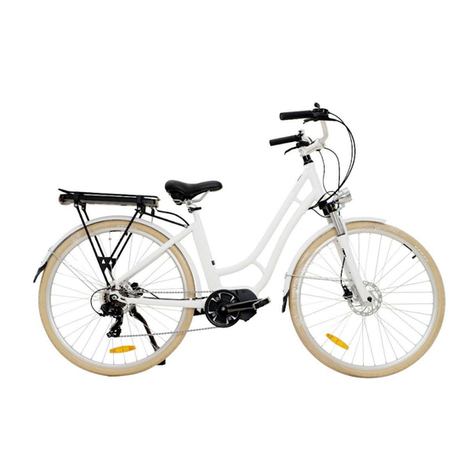
Fortis
Fortis FS7MDLDBWMA User manual

Fortis
Fortis 700C BAFANG User manual
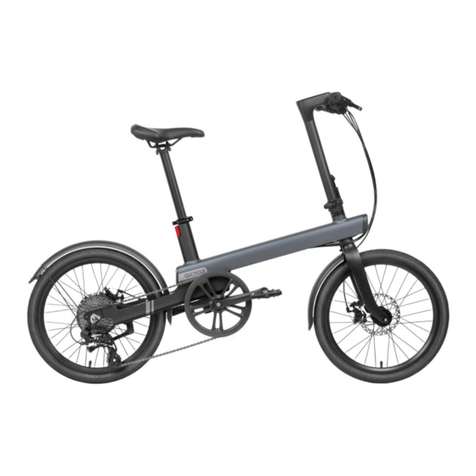
Fortis
Fortis QiCYCLE 20 User manual

Fortis
Fortis FS20ELBIKEB User manual
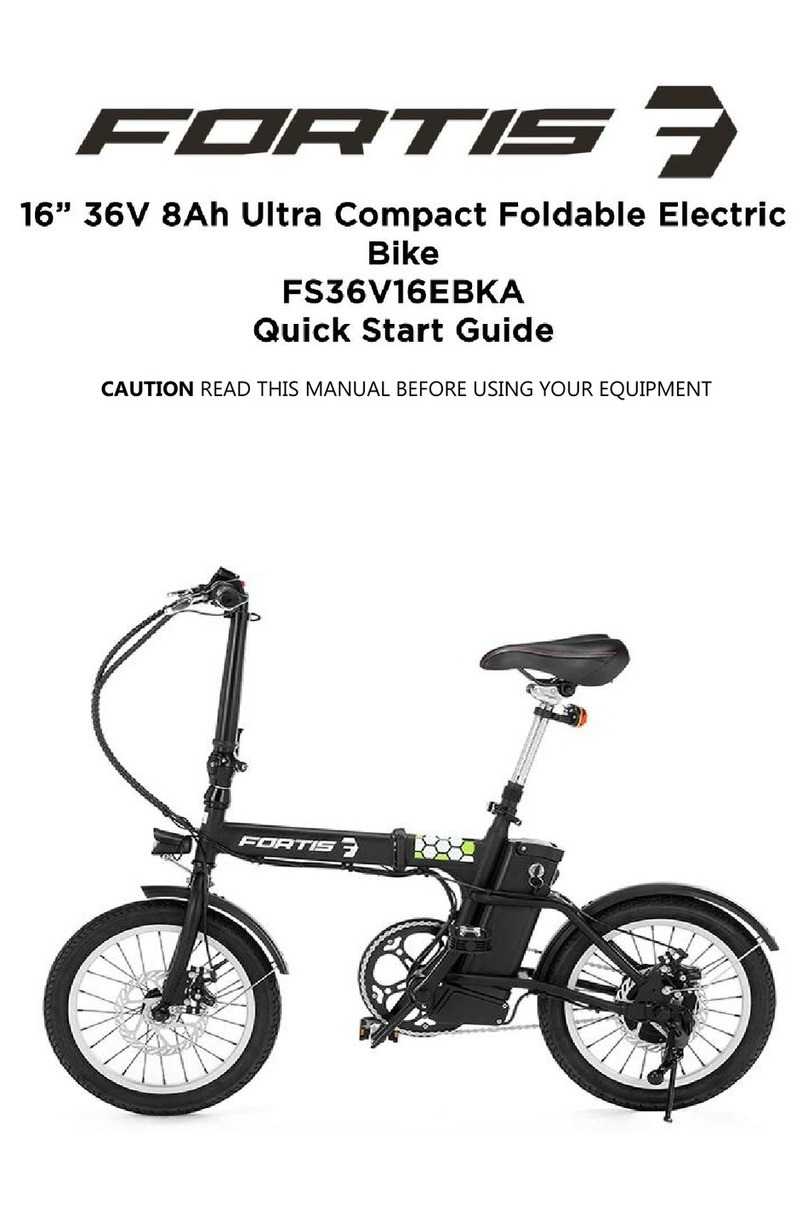
Fortis
Fortis FS36V16EBKA User manual

Fortis
Fortis FS20ELBIKEC User manual
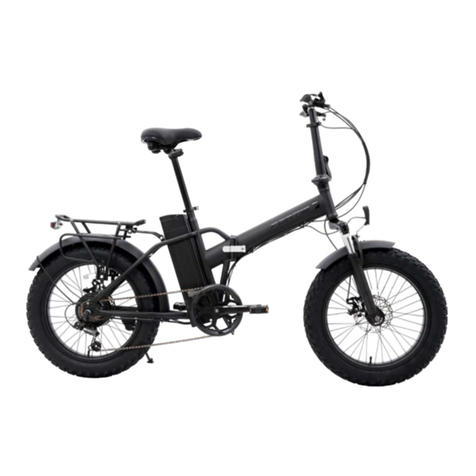
Fortis
Fortis FS20FATEBKC User manual
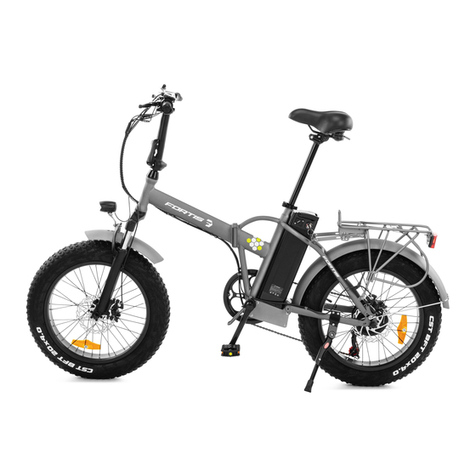
Fortis
Fortis FS20FATEBKB User manual

Fortis
Fortis FS36V16EBKA User manual

Fortis
Fortis CITY BREEZE+ User manual
